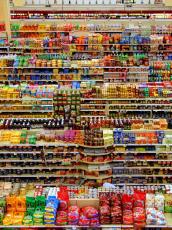Food-Assistance Programs Have Positive Impacts on Food Retail
By Timothy K.M. Beatty, Marianne P. Bitler, and Cynthia van der Werf, UC Davis
Food assistance is a large part of the food economy, with Supplemental Nutrition Assistance Program (SNAP) redemptions totaling $76 billion in 2013, representing more than 10 percent of sales at supermarkets. Such assistance is important to the millions of Americans who depend on it. Less clear until now has been how food assistance shapes the retail food environment. In a recent study, we set out to find out whether the rollout of Food Stamps during the 1960s and 1970s affected the retail environment. We found that locations which rolled out the Food Stamp Program earlier had more food stores, more workers in food and grocery stores, and higher real sales. This suggests that current policy proposals to shrink the federal food-assistance budget would have unintended negative consequences for the retail food environment.
Key Facts
- SNAP redemptions totaled $76 billion in 2013, representing more than 10 percent of sales at supermarkets.
- Rollout of the Food Stamp Program in the 1960s and 1970s lead to more people working in food and grocery stores, more employment, higher real payroll, and higher real sales.
- Food-assistance programs likely affect the retail food environment, bringing benefits to both participants and nonparticipants.
Federal nutrition programs are a cornerstone of the food economy. In 2017, around $63 billion in SNAP benefits were redeemed. These were accepted at 263,105 firms, with the majority—about $58 billion—spent at superstores or supermarkets.[1] This is on a total base of total grocery store sales of roughly $625 billion in 2016. Food-assistance programs are automatic stabilizers in times of economic downturn for recipients and retail food stores alike.[2] During the Great Recession, SNAP spending accounted for more than 10 percent of food-at-home spending. Indeed, it was the largest source of such spending for low-income Americans.[3]
The Food Stamp Program arose in the early 1960s, beginning with pilot programs. In 1964, the passage of the Food Stamp act allowed counties or cities who wanted to participate to apply to do so. Participation in the Food Stamp Program was made mandatory for counties in the early 1970s, with the goal of all counties being on the program by the mid-1970s. The modern means-tested Food Stamp Program works by providing eligible low-income individuals with additional resources that families can use to purchase raw ingredients for foods. Food Stamp benefits cannot be used for prepared foods.
By increasing the resources available to households, SNAP benefits lead participants to spend more on food. This is particularly true among the extra-marginal consumers who would consume fewer unprepared foods in the absence of SNAP. Given that retailers will, all else being equal, choose to open and locate in areas where demand is highest to maximize profits, it follows that SNAP likely influences these choices for food retailers. Recognizing this fact enables us to make two observations. Firstly, increased SNAP participation and spending of benefits in a given area may induce stores to open or expand, which in turn may increase the amount of food that can be bought with a given level of benefits to participants. Secondly, to the extent that food-assistance programs improve the food environment, both participants and nonparticipants may benefit.
It is well known that low-income neighborhoods have less access to large-format retailers, and that a low-quality food environment is associated with a number of adverse outcomes.[4] Meanwhile, access to food stores—particularly large-format retailers—is associated with greater selection and lower prices, directly increasing the amount of food that can be purchased with a set amount of food assistance.[5] Some research suggests that proximity to a supermarket is also associated with a healthier diet, better health outcomes (such as reductions in obesity) and decreased rates of food insecurity.[6,7,8] Understanding how food assistance affects store-location and expansion decisions is therefore very important.
Measuring the Impact of Food Stamp Rollout
In our study, we leveraged the shock to local food environments provided by the rollout of the Food Stamp Program in the 1960s and early 1970s. We used this variation to see if increased food spending spurred by this program led to more food stores, increased real sales, more food employment, and higher real payroll. This provides evidence about how transfer programs such as SNAP affect the retail environment, leading to possible spillovers even beyond the diets of those on these programs.
To do this, we used data from select years in the 1950s, 1960s, and 1970s. Specifically, we made use of newly digitized Census of Business and Census of Retail Trade data on real sales and the number of firms by sector; County Business Pattern data on the number of firms, employees, and payroll by sector; and Decennial Census data on workers in those industries. To identify the effect of Food Stamps on real sales, the number of supermarkets and food stores, real payroll, employment, and other measures of the food environment, we used a well-tested causal empirical design. We deployed a differences-in-differences approach while controlling for national and other relevant trends. This enabled us to compare outcomes in counties after they had implemented Food Stamps with those before, while controlling for other changes.
Food Stamps Led to More Stores and Higher Employment, Sales, and Salaries
We found that adoption of the Food Stamp Program led to between a 1.3 and 1.6 percentage point increase in real sales (in food stores), using the Census of Retail Trade data. These are economically meaningful effects. They compare to about a 6 percentage point participation rate per capita for Food Stamps within a year after rollout.
Our analysis of the County Business Pattern Data suggested that any rollout was associated with a 4.9 percent increase in employment in food stores and a 5.3 percent increase in grocery stores. Employment in eating and drinking places (such as restaurants and diners) saw no change. In terms of real payroll, effects of rollout were a 4.2 percent increase for food stores and also a 4.2 percent increase for grocery stores. We found, too, with Decennial Census data, that SNAP rollout led to a 2.6-2.8 percent increase in employment in food stores, while grocery stores saw a similarly sized increase of about 3 percent.
Overall, we found remarkably consistent findings across the three different data sets, each of which spanned a different time period. Rollout of Food Stamps led to more workers in food and grocery stores, more employment, higher real payroll, higher real sales, and more stores.
Shrinking Federal Food-Assistance Budget May Harm Participants and Nonparticipants Alike
Our study found compelling evidence that increases in store openings and employment were related to SNAP rollout. These may have generated positive spillovers both to participants and non-participants. We found that Food Stamp rollout increased sales in food stores by 1-2 percent and increased employment in food stores by between 3 and 5 percent. Our results suggest that there are important effects of the largest food assistance program (SNAP) on the retail food environment. In light of this, current policy proposals to shrink the federal food-assistance budget would likely have unintended negative economic consequences, while maintaining or expanding the program would likely lead to more positive retail outcomes.
Timothy K.M. Beatty is a Professor of Agricultural and Resource Economics at the University of California, Davis.
Marianne P. Bitler is a Professor of Economics at the University of California, Davis and a Research Associate at the NBER.
Cynthia van der Werf is a PhD candidate in the Department of Economics at the University of California, Davis.
This policy brief was supported by funding from the UC Office of the President Multicampus Research Programs and Initiatives, Grant MRI-19-601054.
References
[1] USDA. Food and Nutrition Service. SNAP Retailer Management 2017 Summary. 2018.
[2] Bitler M, Hoynes H. The more things change, the more they stay the same? The safety net and poverty in the Great Recession. Journal of Labor Economics. 2016a; 34(S1):S403-S444.
[3] Wilde P. The new normal: The Supplemental Nutrition Assistance Program (SNAP). American Journal of Agricultural Economics. 2013; 95(2):325-331.
[4] Alwitt OF, Donley TD. Retail stores in poor urban neighborhoods. Journal of Consumer Affairs. 1997; 31(1):139-164.
[5] Basker, E. Selling a cheaper mousetrap: Wal-Mart’s effect on retail prices. Journal of Urban Economics. 2005; 58(2):203-229.
[6] Gustafson A, Lewis, Perkins S, et al. Association between the retail food environment, neighborhood deprivation, and county-level dietary outcomes among Supplemental Nutrition Assistance Program-Education (SNAP-ED) recipients in Kentucky, 2010-2011. Journal of Hunger and Environmental Nutrition. 2013; 8(3):362-377.
[7] Block JP, Christakis NA, O’Malley AJ, Subramanian SV. Proximity to food establishments and body mass index in the Framingham Heart Study offspring cohort over 30 years. American Journal of Epidemiology. 2011; 174(10):1108-14.
[8] Bonanno A, and Li, J. “Food insecurity and food access in US metropolitan areas.” Applied Economic Perspectives and Policy. 2014; 37(2):177-204.











